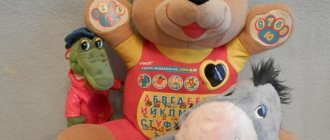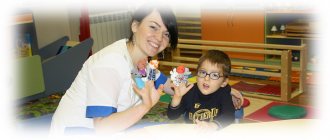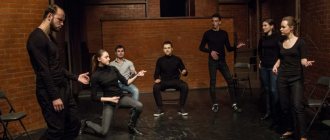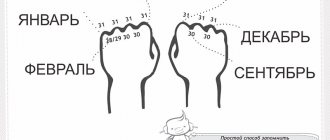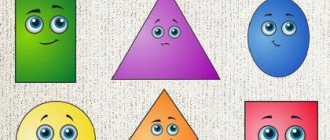Article “Development of imagination in children of senior preschool age”
FEATURES OF IMAGINATION DEVELOPMENT IN SENIOR PRESCHOOL CHILDREN: THEORETICAL ASPECT
Petrukhina T.A.
TSPU named after. L.N. Tolstoy
Tula, Russia
FEATURES OF THE DEVELOPMENT OF IMAGINATION IN CHILDREN OF PRESCHOOL AGE: A THEORETICAL ASPECT
Petrukhina T.A.
Tula State Lev Tolstoy Pedagogical University
Tula, Russia
The relevance of the problem of developing children's imagination lies in the fact that this mental process is an integral component of any form of creative activity of the child, as well as his behavior in general. Imagination is a special property of the human psyche, which stands apart from other mental processes and occupies an intermediate position between perception, thinking and memory. Almost all human culture, material and spiritual, is a product of the imagination and creative activity of people. Thanks to imagination, a person creates, intelligently plans and manages his activities. It is this ability that needs special care in terms of development. Presumably, imagination develops intensively in childhood.
If during this period you do not engage in the development of imagination, subsequently an active decline in this function occurs.
Imagination is the ability of consciousness to create images, ideas and manipulate them; plays a key role in the following mental processes: modeling, planning, creativity, play, human memory. A type of creative imagination is fantasy. Imagination is one of the forms of mental reflection of the world. The most traditional point
vision is the definition of imagination as a process (A.V. Petrovsky and M.G. Yaroshevsky, V.G. Kazakov and L.L. Kondratyeva, etc.). Imagination is a mental process consisting of the creation of new images (ideas) by processing the material of perceptions and ideas obtained in previous experience (M.V. Gamezo and I.A. Domashenko).
In Russian psychology, along with other mental functions, imagination acts as a reflection of the surrounding reality, being social in nature. L.S. Vygotsky believes that imagination is connected with reality, and points out various forms of connection between imagination and reality. The first form is
that any image of the imagination is built from elements of reality and past human experience. The second form is the connection between a product of imagination and a phenomenon of reality. The third form characterizes the connection
emotions. the fourth form of connection between imagination and reality is that the product of imagination may not correspond to a really existing object, but, having acquired material embodiment,
begins to really exist in the world and influence other things. The main line of development of imagination is its gradual
subordination to conscious intentions, the implementation of certain plans, which becomes possible at primary school age in connection with the formation of these psychological formations. The arbitrariness of imagination is manifested in the ability of a primary school student to consciously set goals for action, deliberately seek and find effective means and methods of achieving them.
So, imagination is a form of mental reflection of the world, a special form of the psyche that only a person can have. This is a mental process consisting of the creation of new images (ideas) by processing the material of perceptions and ideas obtained in previous experience. It is continuously connected with
human ability to change the world, transform reality and create new things.
Imagination depends on many factors: age, mental development and developmental characteristics (the presence of any disorder of psychophysical development), individual characteristics of the individual (stability, awareness and focus of motives; evaluative structures of the image of “I”; characteristics of communication; degree of self-realization and assessment of one’s own activities ; character traits and temperament), and, what is very important, on the development of the learning and education process.
A child’s experience develops and grows gradually; it is deeply unique compared to the experience of an adult. The child’s attitude to the environment, which with its complexity or simplicity, its traditions and influences stimulates and directs the creative process, is again completely different. The interests of a child and an adult are different and therefore it is clear that a child’s imagination works differently than an adult’s.
Imagination plays a greater role in the life of a child than in the life of an adult. It allows a preschooler to explore the world around him, performing a gnostic function. It fills gaps in his knowledge, serves to unite disparate impressions, creating a holistic picture of the world.
The baby's growing cognitive needs are largely satisfied with the help of imagination. It seems to remove the distance between what the child can perceive and what is inaccessible to his direct perception. Child imagines lunar landscape, flight
rocket, tropical plants. That is, imagination significantly expands the boundaries of his knowledge. In addition, it allows the preschooler to “participate”
events that do not occur in everyday life. This is "participation"
enriches his intellectual, emotional, moral experience, allows him to more deeply understand the surrounding, natural, objective and social reality.
A child’s imagination begins to develop quite early; it is weaker than that of an adult, but it occupies more space in his life.
Stages of imagination development in preschool children.
Until the age of 3, children’s imagination exists within other mental processes, where its foundation is laid. At the age of three, the formation of verbal forms of imagination occurs. Here imagination becomes an independent process. At first, the imagination is inextricably linked with the object, which serves as an external support. So, in the game, a child of 3-4 years old cannot rename an object if he does not act with it. He imagines a chair as a ship or a cube as a saucepan when he works with them. The substitute item itself must be similar to the item being replaced. It is the toys and objects—the attributes—that lead the child to one or another plot of the game. For example, I saw a white coat, began to play hospital, saw scales, and became a “salesman.” Gradually, the imagination begins to rely on objects that are not at all similar to those being replaced. Thus, older preschoolers use natural materials (leaves, cones, pebbles, etc.) as play materials. The role of visual support in the reconstruction of a literary text is especially pronounced. This is the illustration, without which the youngest preschooler cannot recreate the events described in the fairy tale. For older preschoolers, the words of the text begin to evoke images without visual support. Gradually, the need for external supports disappears.
At 4-5 years old, the child begins to plan, to make a mental plan for upcoming actions, primarily in play, manual labor, storytelling and retelling. At the age of 5 years, dreams about the future appear and specific planning, which can be called stepwise, begins. Dreams are situational, often unstable, caused by events that caused an emotional response in children. Imagination turns into a special intellectual activity aimed at transforming the surrounding world. The support for creating an image is now not only a real object, but also ideas expressed in words. Begins
rapid growth of verbal forms of imagination, closely related to the development of speech and thinking, when a child composes fairy tales, upside-down stories, and ongoing stories. The preschooler's imagination remains largely involuntary. The subject of fantasy becomes something that greatly excited, captivated, and amazed him: a fairy tale he read, a cartoon he saw, a new toy.
- 6 - 7 years old imagination is active. Recreated images appear in various situations, characterized by meaningfulness
specificity. Elements of creativity appear. External support suggests a plan, and the child arbitrarily plans its implementation and selects the necessary means.
The increase in the focus of imagination throughout preschool childhood can be concluded from the increase in the duration of children’s play on the same topic, as well as from the stability of roles. Younger preschoolers play for 10 - 15 minutes. External factors lead to the appearance of side lines in the plot, and the original intent is lost. They forget to rename items and start using them according to their actual functions. At 4 - 5 years old the game lasts
40-50 minutes, and at 5 - 6 years old children can play enthusiastically for several hours and even days.
When developing a child’s imagination, it is important to remember that the material for his fantasies is the entire life around him, all the impressions he receives, and these impressions must be worthy of the bright world of childhood.
The creative nature of imagination depends on the extent to which children master the methods of transforming impressions used in play and artistic activity. The means and techniques of imagination are intensively mastered in preschool age. Children do not create new fantastic images, but simply transform already known ones, using such imagination techniques as anthropomorphization, agglutination, hyperbolization and others. Mastering the techniques and means of creating images leads to the fact that the images themselves become more diverse, rich, emotional,
permeated with aesthetic, cognitive feelings, personal meaning.
So, let us highlight the main features of the development of imagination in preschool age: · imagination acquires an arbitrary character, presupposing the creation of a plan, its planning and implementation; · it becomes a special activity, turning into fantasy; the child masters the techniques and means of creating images; imagination moves to the internal plane, and there is no need for visual support for creating images.
Thus, the child’s imagination is manifested and formed in the process of activity. Specific preschool activities are important in its development: playing, designing, drawing, modeling, etc.
Adults play an important role in shaping a child’s imagination. The teacher creates conditions for children to express their imagination. In the process of organizing and directing children’s activities, he enriches the ideas of preschoolers, teaches them effective techniques for manipulating images of the imagination, using special exercises that stimulate children’s imagination, etc. It is important that the content and form of communication between an adult and a student create an opportunity for the child to enter the “zone of proximal development” and contribute to the realization of his potential in creative activity.
Types of imagination
Experts distinguish several types of imagination.
Creative
Human consciousness allows you to compose incredible images, without relying on knowledge and experience. Such imagination, with its further development, can even become the basis for a person’s future profession related to writing.
Recreating
This type of imagination is based on existing knowledge; images that the child became acquainted with in classes, in communication with relatives and friends appear from memory and are developed.
Wild fantasy
Uncontrolled imagination, where reality and fantasy replace each other. The child constantly thinks about something and declares that all this actually happened.
Imagination disorders and their causes
Children may suffer from a lack of imagination or, on the contrary, their imagination becomes uncontrollable.
Imagination deficits are usually experienced by children with speech impairments, because speech and thinking and imagination are interconnected. With speech pathology, the child thinks primitively, he is not able to create a new image, he cannot invent, compose, and also carry out tasks of an adult where he needs to use his imagination. These children usually have difficulty remembering terms, assimilating the acquired knowledge, and do not understand symbols.
Children who have low self-esteem may also have a deficit of imagination. They are afraid of doing something wrong, they are absolutely deprived of independence, which suppresses imagination.
In this case, teachers need to creatively overcome the child’s inhibition step by step, offering to develop abilities through play, the basis of which will be a situation familiar to the child. A good way out of this situation would be the theater. You also need to focus on cognitive activities to broaden the child’s horizons. Emphasis on emotions will play a big role. What impressed you will leave a mark on your soul, and you will want to learn more about it.
Violent fantasy, which can manifest itself in aggression, lies, fears, and the replacement of the real world with a fantasy world, can also interfere with the normal productive development of the imagination.
The reasons for this inadequate imagination may be the child’s internal fears, problems he has with family and peers, inability to get along with the outside world, as well as other psychological problems.
In this case, it is advisable to contact psychologists who will help create an individual program to eliminate the pathology.

